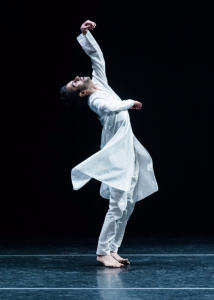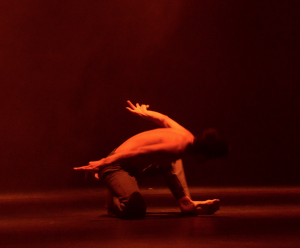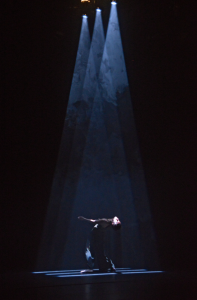Luminous Dance from Aakash Odedra; Sometimes Too Luminous
 Spinning on his heels, arms slashing, Aakash Odedra electrified the stage at the David and Dorothea Garfield Theatre on Tuesday. Odedra, a British dance artist making his San Diego debut, opened his program of four solos with his own “Nritta.” The performance—billed as Aakash Odedra Company, although Odedra was the sole dancer—was presented by UCSD ArtPower in partnership with the San Diego Center for Jewish Culture.
Spinning on his heels, arms slashing, Aakash Odedra electrified the stage at the David and Dorothea Garfield Theatre on Tuesday. Odedra, a British dance artist making his San Diego debut, opened his program of four solos with his own “Nritta.” The performance—billed as Aakash Odedra Company, although Odedra was the sole dancer—was presented by UCSD ArtPower in partnership with the San Diego Center for Jewish Culture.
Like his mentor, internationally known choreographer Akram Khan, Odedra studied the Kathak style of Indian dance, then entered the contemporary-dance world. “Nritta,” which translates as pure dance or pure form, reflects his 27 years of Kathak training. Wearing a traditional knee-length white jacket, he stands quietly and seems to make an invocation. Then he drives his toes into the floor and explodes … into nimble footwork, jumps that appear weightless, vertiginous spins. Just as dazzling are moments of utter stillness when a complex rhythmic pattern resolves.
For the other solos on the program, titled “Rising,” Odedra turned to three contemporary choreographers: Khan, Russell Maliphant, and Sidi Larbi Cherkaoui. And it happened that the order of the pieces here—changed from the printed program—marked a progression from breathtaking to meh.
 The piece Khan made for his protégé, “In the Shadow of Man” feels beautifully crafted for Odedra’s movement style and body. Described in the program as an exploration of humans’ animal nature, the piece also incorporates Khan’s and Odedra’s shared background in Kathak, which often draws on animals for inspiration.
The piece Khan made for his protégé, “In the Shadow of Man” feels beautifully crafted for Odedra’s movement style and body. Described in the program as an exploration of humans’ animal nature, the piece also incorporates Khan’s and Odedra’s shared background in Kathak, which often draws on animals for inspiration.
“In the Shadow of Man” begins with Odedra facing away from us in a crouch, tightly hugging in his arms. His bare back—he has hyper-mobile shoulders—is like a slab of sculpture. He emits a wild cry … and continues to yip and hunker, his fingers curled into claws. He springs up and comes into a contorted fall. Holding his body a few inches off the floor, he scrambles backward like an insect.
The throbbing percussion in Jocelyn Pook’s score gets so intense I can feel it in my body. Suddenly we hear an ethereal female voice, and I’m left wondering, how much distance is there, really, between animal yelps and sublime singing?
In a post-show talkback, Odedra shared how the third and fourth works on the program came about. Khan made “In the Shadow of Man” for him, and his business manager suggested commissioning two other solos to create an evening-length production. Sadly, although Maliphant and Cherkaoui are major European choreographers, both of them did more with the lighting than with Odedra’s gifts as a dancer.
 In Maliphant’s “CUT,” lighting designer Michael Hulls creates the magical effect of illuminating only Odedra’s graceful hands and arms as he “conducts” three cones of light spilling onto the floor. Later he navigates horizontal bands of light, playing with some of the same vocabulary as in “Nritta:” spins, changes of direction, scything arms.
In Maliphant’s “CUT,” lighting designer Michael Hulls creates the magical effect of illuminating only Odedra’s graceful hands and arms as he “conducts” three cones of light spilling onto the floor. Later he navigates horizontal bands of light, playing with some of the same vocabulary as in “Nritta:” spins, changes of direction, scything arms.
Willy Cessa’s lighting for “Constellation,” by Cherkaoui, features some dozen globe-shaped bulbs hanging at different heights; Odedra touches one, it, it turns on, and he sends it into … it’s not just a swing, these lights bounce and jitter! Not a lot happens in the choreography, though; besides getting the lights moving, Odedra does some slow moves on the floor.
In the talkback, Odedra said that the choreography for “CUT” came out of Maliphant filming him as he improvised a warmup; and Cherkaoui did yoga with him. One can’t help but wonder if their commissions were unusually small.
The good news is that Hulls and Cessa are terrific lighting designers, so both pieces had moments of loveliness. But these dances didn’t live up to the incandescent promise of the works by Odedra and Khan.

Award-winning dance journalist Janice Steinberg has published more than 400 articles in the San Diego Union-Tribune, Dance Magazine, the Los Angeles Times, and elsewhere. She was a 2004 New York Times-National Endowment for the Arts fellow at the Institute for Dance Criticism and has taught dance criticism at San Diego State University. She is also a novelist, author of The Tin Horse (Random House, 2013). For why she’s passionate about dance, see this article on her web site, The Tin Horse
